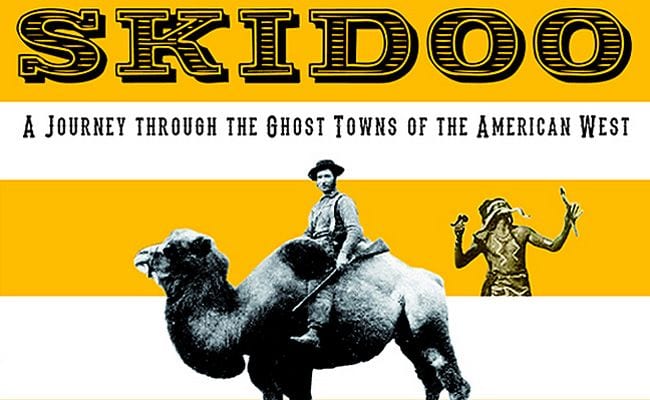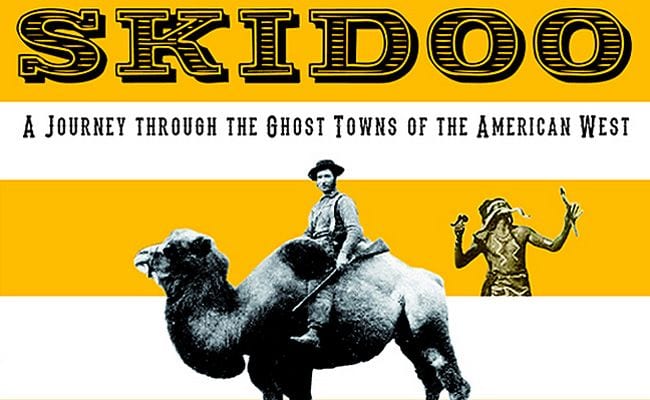
The Wild West has long been a fascination for many, including those who don’t live in the US. French-Swiss novelist, Alex Capus is one such example. His latest book Skidoo: A Journey Through the Ghost Towns of the American West, translated from German into English by John Brownjohn, is a compact little book filled with six madcap tales about the American West in the 19th Century.
The title might suggest the book is aimed at those who like to explore abandoned dwellings; however, it is not about what remains of these ghost towns. There are no photographs of ruined structures or abandoned saloons. Instead, the book is about the wonderfully strange occurrences that once took place in these places and the offbeat inhabitants who once lived there.
Capus is normally known as a novelist, but it’s not surprising to learn that he studied history. He has obviously done his research here, with a book so detailed. It reads like a who knew? of the American West. Within its pages are nuggets of surprising history about 19th Century western life. For example, in the mining town of Bodie, near the Sierra Nevadas, the ground freezes so hard in winters that graves once had to be excavated with dynamite. Add to that the little-known fact that in 1857, 25 camels were imported to the US from North Africa in order for explorers to navigate the deserts of the West, particularly where Route 66 now runs, between Texas and Arizona.
Each chapter is named after a town that Capus explored. He reveals that he has always loved small towns because they remind him of his hometown of Olten, Switzerland. Capus impeccably captures the expanse of the West when he observes that even though western towns remind him of the towns from his homeland, small towns in Western America are “separated by tacks of land capable of swallowing up the whole of the Black Forest, all of Tuscany, and the entire Swiss Alps.”
Stylistically, Capus doesn’t ground the reader with him in the towns he visits. It’s hard to imagine him trekking on foot through the West, as he recounts the histories of these settlements. The reader doesn’t learn how Capus sees these places through his eyes. Instead, everything is told from a rather removed point of view, except when he occasionally jumps in with personal tidbits related to the stories he’s telling. An example can be found in the chapter “Panamint City”, in which Capus recounts his family genealogy and discovers that he may be related to a German brewer who set up a saloon in Death Valley in 1874.
The one time we are able to see the way Capus observes a town he is visiting occurs in the last chapter, “Flagstaff”. It begins with Capus rooting the reader in his reality as he describes his last night of his Wild West journey spent on Route 66. It was a “profoundly depressing experience,” he writes. Let’s just say Capus isn’t a fan of the area. In a book with only a smattering of personal information or opinions, Capus makes it known how he feels about those who spend the latter part of their lives riding their Harleys along the famous stretch of highway. Despite the discordant chapter, Capus’ prose is witty and sharp and digs deep into the dusty ground he is so fascinated with. There’s no doubt he knows how to spin a yarn.
The most entertaining story in the collection is about the title town of Skidoo. Once a settlement in Inyo County, California, Skidoo is located in Death Valley. There are no standing structures left, there is only the town’s history. Its past includes a saloon owner named Joseph Simpson, better known as “Hootch”, due to his talent for knocking back cheap moonshine. According to legend, Hootch was a nasty drunk who wound up lynched and hung from a telephone pole by an angry mob for his bad behavior. After they hung him, the mob took two photos of him: one on a table after they cut him down and one inside the saloon, handcuffed and hanging from the rafters.
From there, the story only becomes more warped, with Capus describing Hootch’s head being decapitated and boiled. His skull was passed around for years and finally denied by a local museum. What happened to the rest of his body is up for speculation, but Capus gives a couple of possibilities…
Another memorable tale involves a man named Jonathan Newhouse, who invented a suit to protect its wearer against heat and sunstroke. What better place to test it than in Death Valley? In 1874, the unsuspecting inventor came to the lethal desert where “lizards lie on their backs to cool their hot feet“ in order to test out his invention. Sadly, Newhouse was found frozen to death inside his suit, with an icicle hanging from his nose, on a day that “must have exceeded 150 degrees”.
Additionally, the collection wouldn’t be complete without the story of the Hopi Indian who tricked Spanish conquistador, Francisco Vázquez de Coronado into giving his people an additional 250 years of freedom by leading him around the prairies of Texas, Oklahoma, and Kansas for over a year with false promises of hidden gold.
It’s these morsels that make the book so charming.


![Call for Papers: All Things Reconsidered [MUSIC] May-August 2024](https://www.popmatters.com/wp-content/uploads/2024/04/all-things-reconsidered-call-music-may-2024-720x380.jpg)



